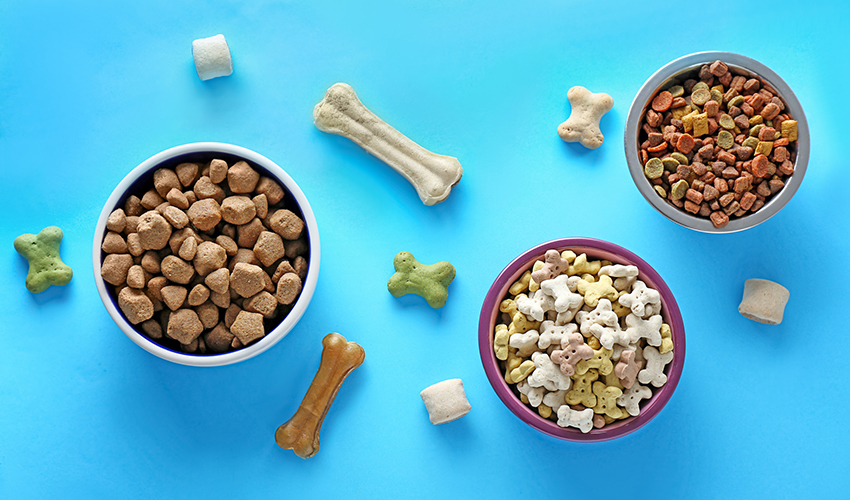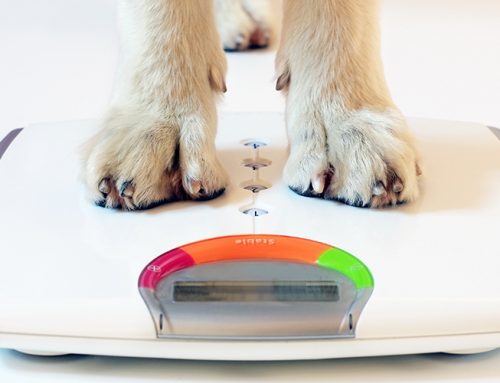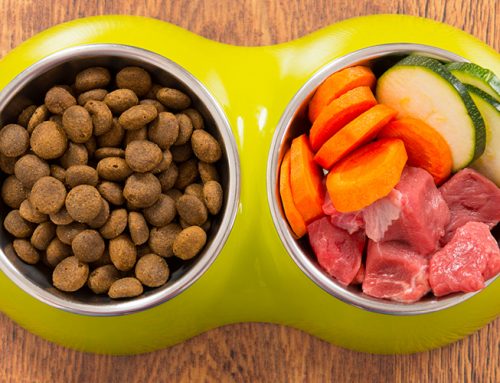Puppies. What’s not to love?
Squirmy, cute, soft, fluffy — and voracious eaters.
Growing is tiring and makes puppies hungry. Some large breed puppies can go from lap-sized to 80 pounds within 12 months! That’s a lot of effort for bones, organs, muscles, skin, fur, and teeth.
Puppy food and adult dog food have different recommended nutritional formulations, which are set by the Association of American Feed Control Officials, or the AAFCO. The AAFCO provides technical information and explanations on the ideal food values for both puppies and adult dogs in a report titled Methods for Substantiating Nutritional Adequacy of Dog and Cat Foods. The guidelines are nutrient profiles based on dry matter.
The major differences are in protein, fat and minerals.
The AAFCO recommends that food for puppies contain a minimum of 22.5 percent crude protein, while adult food should have a minimum of 18 percent crude protein.
Puppies food should offer 8.5 percent crude fat, while adult food should provide about 5.5 percent crude fat.
Recommended mineral percentages are higher for puppies, but recommended vitamin intake is the same for puppies and adults.

Puppies won’t get enough protein if they’re eating adult food, so it’s critical they eat a puppy specific formulation. Most brands carry products clearly marked as being puppy food.
Additionally, puppy food helps puppies grow at an appropriate rate. Vets make a distinction between optimal growth rates and maximal growth rates.
“An optimal growth rate in puppies is ideal,” write veterinarians Krista Williams and Robin Downing for VCA Hospitals. “It is a slow and steady growth rate that allows the puppy to achieve an ideal (optimal) adult body condition while avoiding excessive weight and obesity.”
Williams and Downing define a maximal growth rate as growing a puppy as fast as possible via high fat foods or overfeeding. Maximal growth rates can increase the risk of skeletal deformities, obesity later in life, and a shorter lifespan. Dog obesity is linked to hypertension, heart disease, diabetes, osteoarthritis, heat intolerance and decreased immune function.
You want your puppy to grow at a speed that’s just right.
Oftentimes, puppy food is formulated at a higher caloric density per serving. Puppies have small tummies and can only eat so much in one sitting, which is why they need more calories per bite. You will probably need to feed your puppy around four times per day.
There is one grey area when it comes to buying puppy specific food. Some dog food brands carry dog food “for all stages of life.” This food may meet the nutritional requirements puppies have — read the labels to determine the amount of crude protein (22 percent) and fat (eight percent) is in each serving.
Why is protein so critical?
“Protein has several roles in the body, such as building and repairing muscles and other body tissues,” according to PetMD. “It is also needed to form new skin cells, grow hair, build muscle tissue and more.”
A PetMD article titled The Power of Protein, notes that dogs can’t store up protein in their bodies and they depend on eating it via their daily diet. It’s important that a puppy gets enough protein so it can grow.
“Because amino acids are basically the building blocks of tissues, protein has several functions in a dog’s body,” according to How Stuff Works. “It’s the structural component of connective tissues, as well as hair, skin and nails. But it’s also essential for the immune and musculoskeletal systems.”
Animal protein, which contains 10 essential amino acids, helps ensure your puppy has a glossy coat and healthy skin. Dry or brittle fur suggests that your dog may need more protein, at any age.
Some proteins are better than others — look for specific animal proteins (turkey, or beef, or lamb, or fish) listed in your puppy food ingredients, rather than ‘animal byproduct’ or ‘meat meal.’ Knowing exactly what type of protein your puppy is eating will help you discern if your new puppy has any food sensitivities. Protein should also be at the top of the ingredient list, rather than grains, vegetables or fillers. Dogs aren’t strictly omnivores — veggies, fruit, and grains or other carbs provide nutrients for your puppy, but protein comes first.
“Puppies need to eat more in the way of protein (including higher concentrations of specific amino acids), fat, and certain minerals than do adult dogs,” according to PetMD. “Many manufacturers provide higher amounts of nutrients that are not regulated by AAFCO in their puppy foods. Good examples are the omega-3 fatty acids that have been shown to promote healthy brain and eye development in young animals.”
Why is fat content in puppy food so important?
Fat keeps skin and hair healthy, and supports brain and eyesight development. Fats are highly digestible and provide fatty acids to your pet.
“All fats are made of fatty acids,” according to PetMD. “These fatty acids can be thought of as the building blocks of the different types of fats.”
PetMD notes that fat is an energy source for dogs — fat provides twice the amount of dietary energy that protein and carbs do. In addition, fats:
- Transport nutrients across cell membranes
- Produce metabolites that help control inflammation
- Help form hormones like estrogen, testosterone and progesterone
- Provide a barrier against bacterial and viral invasions
- Help your dog feel full
- Help your dog’s body absorb fat soluble vitamins A, D, E and K.
Is large breed puppy food different then regular puppy food?
Yes! It should be. Large breed puppies in particular need to grow at an optimal rate. Large breed puppies are any breed that will top 60 pounds or more in adulthood. Large breed puppy chow should be lower in fat, lower in calcium, lower in phosphorus, and lower in vitamin D. This makes it slightly different from regular puppy food.
“[Large breed puppies] are at a higher than average risk for developmental orthopedic diseases,” according to PetMD. “Overly rapid growth appears to be an important factor in determining which individuals develop these conditions and which do not. Large breed puppy foods are slightly lower in fat, contain a little less calcium and phosphorus, and have a carefully balanced calcium to phosphorus ratio to help these dogs grow at a healthier rate.”
Using portion control with your large breed puppy can decrease the chances of it developing conditions like hip dysplasia — but your dog will still reach its full adult size.
Don’t feed large breed puppies treats with added calcium.
Many brands carry specific large breed food with unique formulations to address the nutritional needs of big dogs. Large breeds can be prone to osteoarthritis so a diet higher in fatty acids and glucosamine may be required. Your vet, breeder, or rescue facility will be able to provide specialized suggestions.

Is small breed puppy food different then regular puppy food?
Like big dogs, small dogs and their extra tiny tummies also have unique needs.
“The differing metabolic rate of small versus large breed dogs continues into adulthood, which means that small dogs need to take in more calories per pound than large dogs,” writes veterinarian Jennifer Coates, for PetMD. “A little math reveals that the small dog requires 40 calories/pound, while his large breed friend needs only 22.5 calories/pound. Combine this with the fact that small dogs have tiny stomachs and you’ll see why most foods designed for small breeds are somewhat more calorie rich than large breed diets.”
Small breed puppies are at a higher risk of hypoglycemia (low blood sugar) because they have high metabolic rates and low fat reserves. This is why a calorie dense puppy food, fed up to six times a day, is important to keeping your small breed puppy healthy. Symptoms of hypoglycemia are weakness, lethargy, muscle tremors and seizures.
Small breed kibble is often smaller sized than regular puppy kibble, which reduces the risk of choking for small dogs.
When can my puppy eat adult food?
Dogs can switch to adult food when they are about 80 per cent of their full size — for large dogs, this can be anywhere from 12 to 18 months old. Some large breeds don’t reach this benchmark until 24 months. Small breed dogs may hit the 80 percent milestone between 7 and 9 months old.
Consult with your vet or dog breeder for advice about changing over to adult dog food.






